Introduction
- Books Name
- CBSE Class 6 Science Book
- Publication
- Param Publication
- Course
- CBSE Class 6
- Subject
- Science
INTRODUCTION
You all know that food, clothing and shelter are the three basic needs of life. Yue eat food survive and protect yourself from diseases, you need a house to live in. We wear clothes for protection against climate, for modesty and beauty, and also to show status. The material that you use for clothing is called fabric.
If we go to a shop to buy fabric for our dress, we would see a variety of fabries there. Those fabrics are made up of many types of fibres. Some materials are warm, some are soft, some fabrics materials go bad after washing while others remain the same.
Variety in Fabrics
- Books Name
- CBSE Class 6 Science Book
- Publication
- Param Publication
- Course
- CBSE Class 6
- Subject
- Science
HISTORY OF CLOTHING MATERIAL
In ancient times people used the bark and big leaves of trees or animal skins and furs to cover themselves.
After people began to settle in agricultural communities, they learnt to weave twigs and grass into mats and baskets. Vines, animal fleece or hair were twisted together into long strands. These were woven into fabrics. The early Indians wore fabrics made out of cotton that grew in the regions near the river Ganga. Flax is also a plant that gives natural fibres. In ancient Egypt, cotton as well as flax were cultivated near the river Nile and were used for making fabrics.
In those days, stitching was not known. People simply draped the fabrics around different parts of their body. Many different ways of draping fabrics were used. With the invention of the sewing needle, people started stitching fabrics to make clothes. Stitched clothes have gone through many variations since this invention. But, it is also amazing that even today saree, dhoti, lungi or turban is used as an un-stitched piece of fabric.
Just as there is a large variety in the food eaten all over our country, a large variety exists also in fabrics and clothing items.
Fibre
- Books Name
- CBSE Class 6 Science Book
- Publication
- Param Publication
- Course
- CBSE Class 6
- Subject
- Science
Yarn to fabric
There are many ways by which fabrics are made from yarns. The two main processes are weaving and knitting.
(a) Weaving : The process of arranging two sets of yarns together to make a fabric is called weaving.
Two sets of yarn are woven to make a fabric. The yarns are much thinner. Weaving of fabric is done on looms. The looms are either hand operated or power operated.
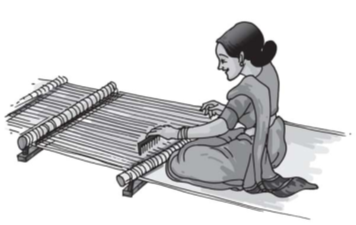
Handloom
Activity–2
Aim : Weaving of paper strips.
Materials required : Sheets of paper of differnt colours.
Method : Cut square pieces of length and width equal to 30 cm from each sheet. Now, fold both the sheets into half. On one sheet draw lines as shown in
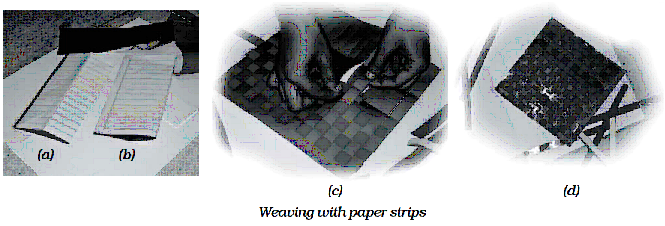
(a) and on the other as shown in (b). Cut both the sheets along the dotted lines and then unfold. Weave the strips one by one through the cuts in the sheet of paper as shown in (c). Fig. (d) shows the pattern after weaving all the strips.
(b) Knitting : In knitting, a single yarn is used to make a piece of fabric A single yarn gets pulled out continuously as the fabric gets unravelled. Socks and many other clothing items are made of knitted fabrics. Knitting is done by hand and also on machines.
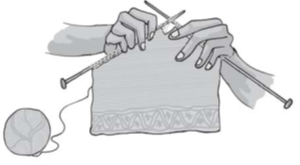
Knitting
Spinning Cotton Yarn
- Books Name
- CBSE Class 6 Science Book
- Publication
- Param Publication
- Course
- CBSE Class 6
- Subject
- Science
YARN
Fibres are thin and small cannot be made into a fabric directly. So they are first converted into yarns which are longer, thicker and stronger.
A yarns is a continuous strand made up of a number of fibres which are twisted together.
(i) Yarn making
The process of making yarns from fibres is called spinning. Here the fibres are not only twisted but also pulle out or drawn.
The spinning process helps to hold the fibres together and makes the yarns strong, smooth and fine. Spinning can be done by using a takli(spindle), a charkha or a spinning machine.
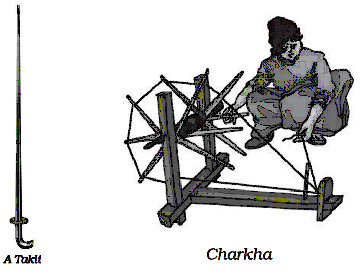
AIM : To show no. of strands in yarn.
Material required : A yarn of cotton fabric.
Method : Place this piece of yarn on the table. Now, press one end of the yarn with your thumb. Scratch the other end of the yarn along its length with your nail as shown. This yarn splits up into no. of strands.

FABRIC
Fabric are made using yarns. Fabric is the material that is used to make clothing or household articles.
Some Plant Fibres
- Books Name
- CBSE Class 6 Science Book
- Publication
- Param Publication
- Course
- CBSE Class 6
- Subject
- Science
Some Plant Fibres
(i) Cotton : Cotton plants are usually grown at places having black soil and warm climate. The fruits of the cotton plant (cotton bolls) are about the size of a lemon. After maturing, the bolls burst open and the seeds covered with cotton fibres can be seen.It looks like a field covered with snow.
From these bolls, cotton is usually picked by hand. Fibres are then separated from the seeds by combing. This process is called ginning of cotton. Ginning was traditionally done by hand. These days, machines are also used for ginning.
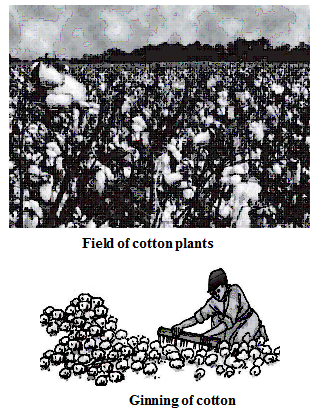
Cotton is cultivated where warm and sunny weather stays for at least half of the year. Cotton plants require warm temperature ranging between 21º C to 27ºC with sunny and dry weather. By the time of harvesting rainfall between 50 cm to 80 cm is another conducive condition for its growth. Black soil, which has the ability to retain moisture is best suited for cotton cultivation. When cotton crop grows to maturity, the seeds with their fibres are harvested. Fibres are separated from the seeds and raw cotton is then shipped to textile factories.
Cotton is used in the manufacture of fish nets, coffee filters, tents and in book binding.
In India, main cotton producing states are Maharashtra, Haryana, Andhra Pradesh, Punjab and Gujarat. Sourthern United states, China and India are the largest producer of cotton.
Yarn to Fabric
- Books Name
- CBSE Class 6 Science Book
- Publication
- Param Publication
- Course
- CBSE Class 6
- Subject
- Science
Fibres
A hair like strand from which all fabrics are made, are know as fibres.
CLASSIFICATION OF FIBRES

(a) Natural Fibres :
Fibres obtained from plants and animals are called natural fibres. For example cotton, jute, wool and silk.
(i) Plant fibres : The fibres obtained from plants are known as plant fibres
Example : cotton, jute
(ii) Animal fibres : The fibres obtained from animal are known as animal fibres.
Example : wool and silk
(b) Semi-synthetic fibres :
These are obtained from naturally occurring fibres by chemical modifications. For example, cellulose on reaction with acetic anhydride in the presence of concentrated sulphuric acid gives cellulose diacetate, which is used for making threads of acetate and other materials like films and glasses.
(c) Synthetic (artificial) fibres :
Synthetic fibres are manufactured by man in the laboratories. For example: nylon, acrylic and polyester.
History of clothing material
- Books Name
- CBSE Class 6 Science Book
- Publication
- Param Publication
- Course
- CBSE Class 6
- Subject
- Science
(ii) Jute :
Jute fibre is obtained from the stem of the jute plant. It is cultivated during the rainy season. In India, jute is mainly grown in West Bengal, Bihar and Assam. The jute plant is normally harvested when it is at flowering stage. The stems of the harvested plants are immersed in water for a few days. The stems rot and fibres are separated by hand.
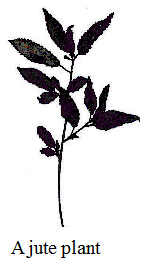
It is a long, soft , shiny plant and is one of the cheapest natural fibres. Jute fibres are composed of cellulose and lignin.
• Jute is a rainy season crop, grown best in warm, humid climate.Jute plant requires temperature ranging from 17ºC to 40ºC and rain fall from 120 mm to 150 mm
• Almost 85% of the world’s jute cultivation is concentrated in deltas of Ganga.
• Harvesting of jute plant is done at flowering state. The stalks are cut close to the ground. They are then tied into bundles and soaked in water for 20 days. It softens the tissues and permits the fibres to be separated. The fibres are then stripped from the stalks in long strands and washed in clear, running water. Then they are spread on a that ched roof to dry.
• Jute is said to have more than a thousand uses. It is the second most important vegetable fibre after cotton, not only for its wider cultivation, but also for its uses.
• Jute is used to make cloth for wrapping bales of raw cotton, and to make sacks and coarse cloth. Jute fibres are also woven into curtains, chair coverings, bags, carpets, hessian cloth, etc
KEY WORDS
1. Cotton wool : Cotton wool is obtained from cotton plant. It is made up of thin cotton fibres.
2. Fabric : Woven material (cloth) is called fabric.
3. Fibre : Thread like animal or plant tissue is called a fibre.
4. Knitting : Knitting is a process of making a piece of fabric from a single yarn.
5. Spinning : The process of making yarn from fibres is called spinning.
6. Weaving : The process of arranging two sets of yarn together to make a fabric is called weaving.
7. Yarn : Spun fibres are called yarns.

 Param Publication
Param Publication
 PathSet Publications
PathSet Publications
